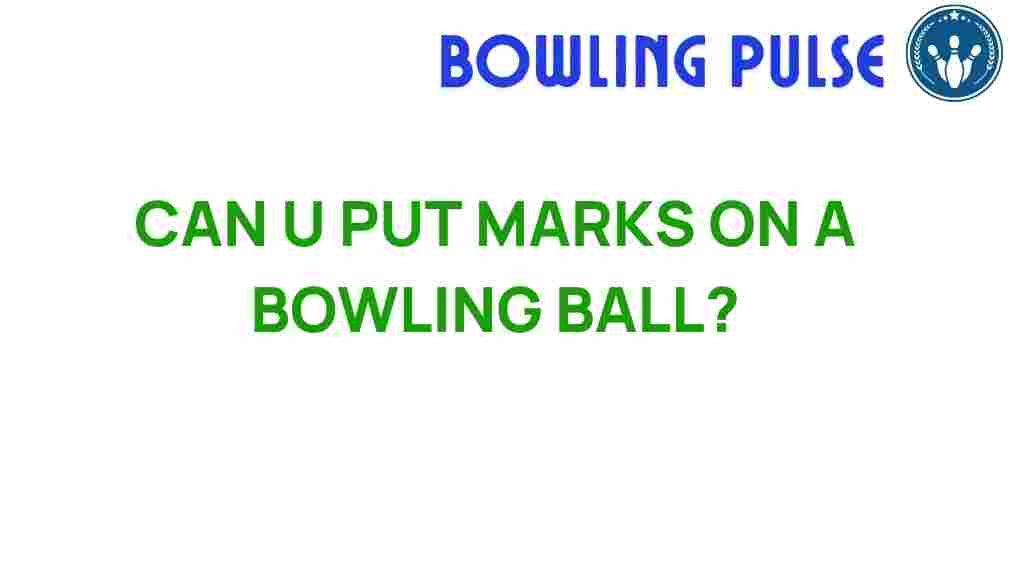The Truth Behind Marking a Bowling Ball: Does It Help Performance?
Bowling is a sport that combines skill, technique, and a bit of science. For many enthusiasts, the performance of a bowling ball can make a significant difference in their overall game. One aspect that often raises questions is the practice of marking a bowling ball. Does it really enhance performance? In this article, we’ll explore the truth behind bowling ball markings, their impact on grip, technique, maintenance, and the rules surrounding them.
Understanding Bowling Ball Markings
Markings on a bowling ball can serve various purposes, from aesthetic appeal to functional benefits. Here’s a closer look at why bowlers mark their balls.
- Identification: Markings help bowlers identify their own ball among many others in a bowling alley.
- Alignment: Markings can assist bowlers in aligning their shots, providing a visual cue to improve accuracy.
- Condition Assessment: They can help assess the wear and tear on the bowling ball, indicating when it needs maintenance.
The Science of Performance
To understand how markings might influence performance, it’s essential to consider the key factors that contribute to the effectiveness of a bowling ball.
- Grip: The grip is crucial for a bowler’s technique. Proper markings can help bowlers position their fingers correctly, which can enhance their grip on the ball.
- Spin: Where you place your fingers can affect how much spin you put on the ball. Markings can guide bowlers in achieving the desired rotation.
- Trajectory: Markings can help bowlers visualize where the ball should go, potentially improving their approach and delivery.
How to Mark Your Bowling Ball
If you’re considering marking your bowling ball for improved performance, here’s a step-by-step guide on how to do it effectively.
- Step 1: Choose the Right Tools
Use a non-permanent marker or tape that won’t damage the ball’s surface. Avoid anything that could affect the ball’s performance.
- Step 2: Identify Key Areas
Decide where to place your markings. Common areas include the grip zone and the track area where the ball contacts the lane.
- Step 3: Make the Markings
Carefully apply your markings. Use a clear and consistent method so you can easily identify them during play.
- Step 4: Test Your Setup
Take your marked ball for a test run. Observe any changes in your grip and technique, and adjust your markings as needed.
Maintenance and Care of Marked Bowling Balls
Maintaining your bowling ball is as crucial as marking it. Here are some maintenance tips to ensure your ball continues to perform well:
- Regular Cleaning: Clean your ball after each use to remove oil and dirt, which can affect performance.
- Reassess Markings: Regularly check your markings to see if they need refreshing or adjustment.
- Storage: Store your bowling ball in a room temperature environment to prevent warping or damage.
Rules and Regulations on Marking Bowling Balls
Before marking your bowling ball, it’s essential to be aware of the rules governing this practice. Some bowling alleys might have specific regulations regarding markings.
- Permanent vs. Temporary: Ensure that your markings are temporary and won’t damage the ball.
- League Rules: Check with your league for any specific guidelines about ball markings.
- Inspection: Be prepared for inspection by bowling officials, especially in competitive settings.
Troubleshooting Common Issues
Even with the best intentions, marking a bowling ball can lead to some unexpected challenges. Here are some common issues and solutions:
- Marker Smudging: If your markings smudge during play, consider using a different type of marker or tape that is more resistant to wear.
- Difficulty in Grip: If you find that your markings are distracting or affecting your grip negatively, try simplifying them or repositioning them.
- Ball Damage: If markings are causing damage to your ball, discontinue their use and consult a professional for advice.
Assessing the Impact of Markings on Performance
After marking your bowling ball and practicing with it, it’s crucial to assess how these changes may have affected your performance. Here are some methods to evaluate your game:
- Track Your Scores: Keep a log of your scores before and after marking your ball. Look for patterns to see if there’s an improvement.
- Get Feedback: Ask fellow bowlers or coaches for their observations on your technique and performance changes.
- Video Analysis: Consider recording your bowling sessions. Analyzing footage can provide insights into how your grip and technique have evolved.
Conclusion: The Final Verdict on Marking Bowling Balls
Marking a bowling ball can indeed have an impact on performance, particularly regarding grip and technique. While not all bowlers may benefit equally from this practice, many find that strategic markings help them focus on their delivery and improve their overall game. Remember, the key is to use markings that enhance your performance without compromising the integrity of your ball.
Whether you’re a casual bowler or a serious competitor, understanding the relationship between markings and performance can help you make informed decisions about your bowling gear. Experiment with different techniques and markings, and see what works best for you. For more tips on improving your bowling game, check out our Bowling Techniques Guide.
For more information on bowling regulations, visit the Bowling Congress website.
This article is in the category Techniques and created by BowlingPulse Team
